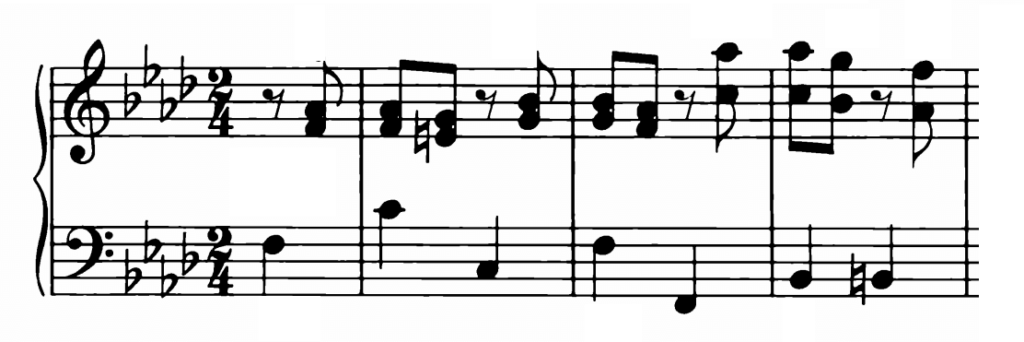Analysis
Contents
Prelude
SUMMARY:
Bars 1-28: Period I. Dominant Pedal (Bars 4-8). Dominant Pedal of Relative major (Bars 16-20). Ending with a Perfect Cadence in the key of the Relative Major, A flat, double bar.
Bars 28-70: Period II. Starting in the Relative Major, it gently moves to E flat (Bar 32), followed by B flat minor (Bars 34-40), and touching D flat major (Bar 43). Landing momentarily on the Dominant (Bar 48), it returns to the Tonic through Sequence to end with a Perfect Cadence in the key of the Tonic, F.
Bars 66-70: Coda. Confirming the Tonic key.
REMARKS:
The Prelude is simple in construction. The First part up to the double bar being composed of short figures in the Treble and Alto parts above – for the most part – a sostenuto Bass, and dividing into seven phrases of four bars each.
The Second part starts with the material of the Opening Bars shifted into the Relative Major, but at Bar 30 curving round, and ending the phrase in E flat major (Bar 32). This part of the Prelude up to the Deceptive Cadence at Bar 60 is also divisible into eight phrases of four bars each.
A new figure appears in the Treble at Bars 40-42, used in Sequence a tone lower at Bars 42-44.
The short figure of four notes in the same part at Bars 44-45 is used in Sequence a tone higher at Bars 45-46.
A free version of the Opening Subject appears at Bars 48-52 in the two under-parts, accompanied by florid figures in the upper part. When Bar 56 is reached the Theme asserts itself in a prominent manner in the two upper parts, its entry being prepared for by a half Cadence on the Dominant.
The framework of this Prelude is that of the early Binary type, but the movement contains distinct traces of an effort to break through this limited form, into something wider and more ample – in short that it is striving after and, is prophetic of, the more developed form of the Modern Sonata. The material immediately following the double bar is a transposition of the Opening into the key of the Relative Major, and momentarily points back to the early type, but it is at once succeeded by matter which more distinctly points forward to the Modern Sonata form, the harmonic bases are used with greater freedom and in Sequence, consequently the keys change more rapidly and greater colour is obtained, this Section of the movement stretching forward to that which in the Modern type is termed the “Development” or “Free Fantasia” portion. There is a Recapitulation of the Opening material much later in the movement (Bar 56) and it is notable that its entry is even slightly anticipated in the two under-parts (Bar 48), but so judiciously curved as to not interfere with its pronounced Recapitulation just afterwards.
Throughout the movement it is remarkable how strong was the determination to satisfy every demand of unification, and in the latter part of the movement to firmly clench the Tonic key.
Fugue
ANALYSIS:
ENUNCIATION SECTION:
Bars 1-4: Subject in Treble [F minor]. The first quaver (eighth note) has not been reckoned as a bar.
Bars 4-8: Tonal Answer in Alto. No Counter-subject [C minor].
Bars 8-11: Codetta, modulating from C to F minor.
Bars 11-15: Subject in Bass [F minor].
MODULATORY SECTION:
Bars 15-24: Episode I, modulating from F minor to A flat major.
Bars 24-28: Subject in Treble [A flat major].
Bars 28-32: Answer in Alto [E flat major].
Bars 32-40: Episode II, modulating from E flat major, through C, to F minor.
Bars 40-44: Subject in Bass [F minor].
Bars 44-50: Episode III, modulating from F minor, through B flat minor, to F minor.
Bars 50-54: Subject in Alto [F minor].
Bars 54-71: Episode IV, modulating from F minor to B flat minor.
Bars 71-75: Subject in Treble [B flat minor].
RECAPITULATORY SECTION:
Bars 74-78: Subject in Alto [F minor].
Bars 78-85: Coda [F minor].
SUMMARY:
Exposition: Bars 1-15.
Counter-exposition: None.
Codetta: One.
Stretti: None.
Episodes: Four.
Dominant Pedal: Bars 50-53.
Coda: Bars 78-85.
REMARKS:
- This Fugue has a “tonal” Answer, and would be called a “tonal” Fugue. The alteration in the Answer, for the sake of tonality, is made from the first note to the second.
- There is no Stretto proper, though there is a momentary overlapping of the Subject and Answer at Bars 74-75.
- Four Episodes:
- Episode I (Bar 15) is constructed in the Bass from the second limb of the Subject, the Treble and Alto having new figures in which Suspensions are introduced.
- Episode II (Bar 32) is much on the lines of Episode I, but the figures are placed in different voices. At Bar 39 detached figures are given to the Treble.
- Episode III (Bar 44) has a running Bass of the same construction as Episode I, the Treble and Alto having a new figure. At Bar 49 a running Counterpoint is commenced in the Treble, the Bass reiterating the Dominant Pedal.
- Episode IV (Bar 54). In this the chief interest is centered in the Bass, which is made up of fragments suggested by the first limb of the Subject. There are new figures in the Treble and Alto, the former and latter commencing at Bar 55.
- Episodes II, III and IV have only one Entry between each of them.








